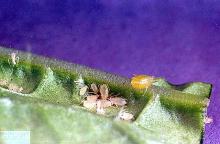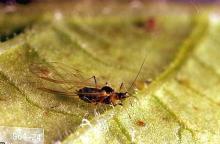Geranium aphid (Acyrthosiphon malvae)
Green peach aphid (Myzus persicae)
Pest description and damage Several species of aphids may feed on the foliar, stem, flower, bud, bark, or root tissues of geraniums. Aphids tend to be small (0.0625 to 0.125 inch in length), oval to pear-shaped, soft-bodied insects with piercing-sucking mouthparts. Color varies (black, green, pink, yellow, mottled, striped, etc.), but most aphids tend to match host plant coloration. Aphids tend to feed in colonies and are found on the new or most succulent plant tissues. Feeding damage to mature plants is usually minor, but can compromise the vigor of the host. When aphid populations are high, leaf and shoot distortion can occur. Aphids produce honeydew, a sweet, sticky secretion that collects on underlying plant tissues and encourages growth of a black sooty mold. In addition to cosmetics, honeydew may become a sticky nuisance when it falls on decks, or landscape surfaces. Some aphids are vectors of plant diseases, particularly viruses.
For biology, life history, monitoring and management
See "Aphid" in:
Management-chemical control
See Table 1 in:




